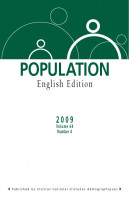
Population 2009, n° 4
2009
- ARTICLES
- Stillbirths in Nineteenth-Century Paris: Social, Legal and Medical Implications of a Statistical Category - V. Gourdon, C. Rollet
- Homosexuality and Bisexuality in Senegal: A Multiform Reality - J. Larmarange, A. Desgrées Du Loû, C. Enel and A. Wade
- Female Schooling and Marriage Change in India - P. Dommaraju
SHORT PAPERS
- Residential Mobility Trends in France, 1973-2006: New Estimates - N. Donzeau, J.-L. Pan Ké Shon
- Estimating Repeat and Return Migrations among Sub-Populations in France - J.-F. Royer
BOOK REVIEWS
Vincent Gourdon, Catherine Rollet
In the nineteenth century, the stillbirth rate in Paris was higher than in the rest of France, representing almost one birth in ten at the end of the century. These data, provided by the statistical institutions, reflect the difficulty of defining the category of stillbirths, located at the boundary between life and death, and subject to conflicting social viewpoints. After reviewing the legislation under the Ancien Régime and the Revolution, this article shows the confusion that prevailed after 1806 in the definitions used in the recording of stillbirths due to multiple pressures exerted by the different ministries, which in turn reflected the contradictory views held by the judicial system and by statisticians. For a long time, this confusion made it impossible to distinguish between "true stillbirths" and "false stillbirths". Moreover, two factors increased the stillbirth rate in Paris: the early introduction of medical verification of births and deaths that occurred in the home, which improved the recording of stillbirths; and an obsessive fear of criminal abortions, which led to stricter monitoring of miscarriages, and to the recording of foetuses as stillbirths at ever earlier gestational ages.
Homosexuality and Bisexuality in Senegal: A Multiform Reality
Joseph Larmarange, Annabel Desgrées Du Loû, Catherine Enel and Abdoulaye Wade
The first surveys on men who have sex with men (MSM) carried out in Senegal in the context of the fight against AIDS, revealed high rates of bisexuality. In 2007, a new epidemiological and behavioural survey (ELIHoS) approached the question of bisexual practices in greater depth. That survey is used here to depict the plurality of forms that bisexuality may take in Senegal. A six-group typology of current modes of sexual activity was constructed based on the characteristics of sexual partners over the past year and at the time of the survey. Various factors in the respondents’ social and sexual life event histories were then analysed according to their current mode of sexual activity. It showed that these modes correspond to different sexual practices and characteristics of first sexual intercourse with a man. However, the systematic use of a condom for similar sexual practices did not depend on the mode of sexual activity. Fewer men who engaged in regular intercourse with women and only occasionally with men were infected with HIV because they less frequently engaged in high-risk anal intercourse.
Female Schooling and Marriage Change in India
Premchand Dommaraju
This study examines the influence of schooling on entry into marriage for women using panel data from the Indian censuses. Both schooling levels and marriage age increased in India between 1981 and 2001. While results from the cross-sectional data show that schooling is positively associated with delays in entry into marriage, results from the panel models suggest schooling to have a limited influence on marriage timing, especially during the 1981-1991 period. It had a significant, though modest, influence during the 1991-2001 period, however. The findings suggest that the association between schooling and marriage seen in the cross-sectional analyses might have been due to unobserved factors influencing both schooling and marriage. Indeed, secular changes in marriage age were more important than changes in schooling levels in determining the timing of marriage before age 20. Further, the results from instrumental variable models suggest that the relationship between schooling and marriage is not endogenous: improvements in schooling levels are independent for the most part from changes in marriage age.
Residential Mobility Trends in France, 1973-2006: New Estimates
Nathalie Donzeau, Jean-Louis Pan Ké Shon
This research paper tracks annual trends in French residential mobility from 1973 (end of the post-war boom years) to 2006. Two different estimation methods are used: Daniel Courgeau’s migrants-migration model and a more direct method applicable to the Housing Survey and to the Employment Survey series. The results of these estimates are compared with those already published in the French literature by various authors using the migrants-migration model. Residential mobility fell between 1973 and 1984, then rose to a peak for the study period in 1999. It then declined and subsequently stabilized - temporarily at least - at a high level. The increase in mobility since the early 1980s has mainly involved moves over short distances: changing residence within the same commune or moving to a new commune in the same département. This finding suggests that the changes in family structure over this period have had a greater impact than occupational mobility.
Estimating Repeat and Return Migrations among Sub-Populations in France
Jean-François Royer
Many people who have migrated internally move again, often back to their earlier location. This paper examines these well-known phenomena using a French administrative data source, a panel sample taken from employers’ annual declarations of tax and social security data (DADS). Descriptive statistics on migration at ages 25-35 of cohorts born in 1966, 1968 and 1970 reveal the main characteristics of successive migrations. Using a "mover-stayer" model, estimates are made of the proportions of the population exposed to the risk of migration or further migration, and of the probabilities of various types of migration occurring among the people exposed to that risk. Repeat and return migrations are observed to vary considerably by cohort and, within a given cohort, by population category. This variability must be taken into account when applying the relationship between number of migrants and numbers of migrations proposed by Daniel Courgeau in 1973, and used since then to establish series of internal mobility rates from population censuses.
Prix TTC : 20,00 €

